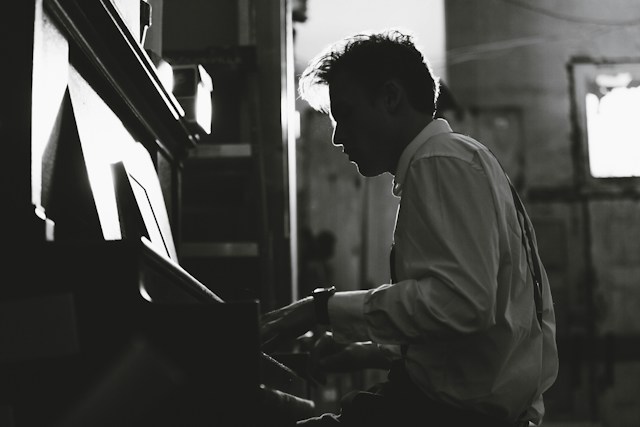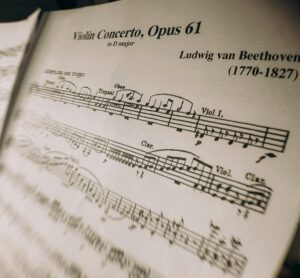Suspended chords, often abbreviated as “sus” in music, represent a fascinating and unique element within the tapestry of musical harmony. Unlike traditional chords, which are firmly rooted in a sense of resolution, suspended chords introduce an air of anticipation and unresolved tension, adding a distinct color and emotional depth to musical compositions.
At their core, suspended chords are about temporarily delaying the expected harmonic resolution. This is typically achieved by replacing the third of a chord with either a second (sus2) or a fourth (sus4), creating a sound that is neither major nor minor but suspended in a state of harmonic ambiguity. This clever manipulation of notes introduces a sense of tension, waiting to be resolved back to a more stable, familiar sound.

Varieties of suspended chords
Suspended chords are primarily categorized into two types: the suspended 2nd (sus2) and suspended 4th (sus4) chords. The sus2 chord, such as a C suspended 2 chord or a D suspended 2 chord, is constructed by replacing the third of a chord with a second. This alteration results in a sound that is open, airy, and ripe with unresolved tension. An example in popular music might include the delicate use of a G suspended 2 chord that gently resolves back to a G major chord, creating a sense of release and resolution.
In contrast, the sus4 chord – think of an E suspended 4 chord or an F suspended 4 chord – substitutes the third with a fourth. This change produces a sound that is fuller and more resonant, yet still suspended in a sense of expectation. A classic example is the use of an A suspended 4 chord in rock ballads, where the chord hangs in the air, creating a moment of emotional suspense before resolving.
Suspended chords beyond the basics
Beyond the basic sus2 and sus4 chords, there are more complex variations. The addition of seventh or ninth notes to a suspended 4th chord, for instance, creates a more complex sound. These advanced chords are often used in jazz and progressive rock, providing a rich tapestry of sound that can elevate a simple melody to something truly mesmerizing.
Understanding the suspended chord formula in these advanced scenarios opens up a world of creative possibilities for composers and arrangers. These chords can act as a bridge between different musical ideas, or as a tool to add depth and complexity to a harmonic progression.
Theoretical foundations of suspended chords
Suspended chords, intriguing in their sound and application, have a straightforward theoretical basis. The labeling of these chords follows a simple yet effective system. A suspended chord is typically denoted by the root note followed by ‘sus2’ or ‘sus4’, indicating the type of suspension. For instance, a D suspended chord could be written as Dsus4 if the third is replaced by a fourth, or Dsus2 if it’s replaced by a second.
The notation of these chords in sheet music follows standard chord notation, with the specific alterations indicated. For beginners, especially those exploring piano through apps like Skoove, understanding these notations is essential for reading and playing music that features suspended chords.
The summary of the video
The video delves into the history and application of suspended chords in music composition, originating from the 1500s during the Renaissance. It explains how composers, seeking variety in their chord progressions, developed suspended chords as an intermediate step between standard chords. The video focuses on three key aspects: how to play suspended chords, their basic uses, and more advanced applications.
There are two main types of suspended chords: the suspended fourth (sus4) and the suspended second (sus2), with the former being more common. The presenter demonstrates how to construct these chords using examples on a guitar. A suspended chord is shown to create tension, sounding unusual due to its major second interval, unlike standard chords which are built on intervals of thirds. This tension typically resolves into a more conventional chord, a common technique in Renaissance music.
The video also explores the unique characteristics of suspended chords, highlighting their ambiguity and lack of a clear major or minor quality. This ambiguity can be artistically leveraged for creating a sense of openness or uncertainty in a composition. However, it also means that suspended chords can lead to unexpected results if not used carefully. The presenter emphasizes the importance of understanding the implications of these chords to fully exploit their potential in music composition.
The tension and resolution of suspended chords
At the core of what makes a suspended chord so captivating is the interplay of tension and resolution. In a typical chord progression, a suspended chord introduces a sense of unresolved musical tension. This tension is then typically resolved by moving to a major or minor chord. For example, in a suspended chord progression, a C suspended chord might resolve to a C major chord, satisfying the listener’s desire for resolution.
The suspended chord formula creates this tension by omitting the third note of the chord, which is crucial in determining whether a chord sounds major or minor. By suspending this piano note and replacing it with a second or fourth, the chord hovers in a state of harmonic ambiguity, waiting to be resolved.
The role of suspended chords in music theory
In music theory, suspended chords serve as a tool for composers to add emotional depth and complexity to their compositions. They can be used to create a feeling of anticipation, suspense, or even a sense of floating, ethereal calm. This is particularly evident in genres like jazz, where suspended chord progressions are often used to add a layer of sophistication to the harmony.
In the context of piano learning, understanding how to identify, play, and resolve suspended chords is crucial. It’s not just about learning the e suspended chord or the f suspended chord in isolation; it’s about understanding their role in a larger harmonic context and how they contribute to the overall emotional and tonal narrative of a piece.
The role of suspended chords in musical composition
Classical music: a foundation of suspense
In classical music, suspended chords have long been used to evoke a range of emotions, from gentle longing to dramatic tension. Composers like Bach and Mozart skillfully incorporated the suspended 4th chord into their compositions, using them as a bridge to lead the listener from one emotional state to another. The usage of a D suspended chord in a classical piece, for example, might create a moment of suspense before resolving into a serene D major chord.
Jazz and modern music: expanding boundaries
Jazz musicians and modern composers have taken the use of suspended chords to new heights. In jazz, the suspended chord formula often includes complex variations like the suspended chord with an added seventh or ninth. These chords, such as a C suspended chord with an added seventh, provide a lush, sophisticated sound that has become a hallmark of the genre.
Modern music genres, including rock and pop, frequently utilize what is a sus chord to add texture and depth to their compositions. The iconic sound of a G suspended chord in a rock ballad or an A suspended chord in a pop song often serves as a memorable hook or a dramatic pause before the chorus.
Suspended chords in film scores
Moreover, film composers frequently use what makes a suspended chord unique to create moods and underscore emotions in cinematic scores. The E suspended chord, for instance, might be used to heighten suspense in a thriller, or a F suspended chord to evoke a sense of wonder in a fantasy film.
Suspended chords in progressions and transitions
Understanding how suspended chords fit into chord progressions is essential for any musician, especially pianists. Suspended chords are often used to add a sense of anticipation or delay in chord progressions. For instance, in a ii-V-I progression, a musician might substitute the V chord with a V sus chord, like a G suspended chord, to create a sense of suspense before resolving to the I chord. This technique is prevalent in both jazz and contemporary music, where it adds an extra layer of emotional depth to the progression.
Suspended chords also serve a crucial role as transitional elements in compositions. They are like musical stepping stones, guiding the listener through different sections of a piece. For example, a composer might use a D suspended chord to transition smoothly from a verse to a chorus, using the unresolved nature of the sus chord to build anticipation.
Practical applications: playing suspended chords
Techniques for voicing suspended chords
Mastering the art of playing suspended chords involves understanding their voicings on various instruments. On the piano, for example, playing a C suspended chord or a G suspended chord requires a specific finger placement that differs from traditional chords. Beginners, using tools like Skoove’s piano learning app, can benefit from visual guides and exercises designed to familiarize them with these placements.
Tips for improvisation: choosing scales over suspended chords
Improvisation over suspended chords, such as a D suspended chord or an E suspended chord, offers a world of creative possibilities. Pianists and guitarists alike can explore different scales that complement the ambiguous nature of sus chords. For instance, using the Mixolydian mode over a suspended chord can create a sense of movement and resolution, perfect for soloing in jazz or rock contexts.
Incorporating suspended chords into improvisation requires a good ear and a deep understanding of how these chords interact within a key. Practice and experimentation, guided by educational resources like Skoove, are key to mastering this skill.
The artistic impact of suspended chords
Suspended chords, with their unique blend of tension and resolution, play a crucial role in music composition and performance. They are not just theoretical concepts, but practical tools that musicians can use to add emotional depth and structural variety to their work.
For learners, particularly those in North America and Western Europe, mastering suspended chords is a step towards more sophisticated musical expression. Whether it’s understanding the subtle difference between a C suspended chord and a G suspended chord on the piano, or experimenting with the placement of an E suspended chord, the practical application of these chords is essential.
Ultimately, the true value of suspended chords lies in their ability to enhance a musician’s creative palette. They offer a way to experiment with sound, create tension and resolution, and contribute to a more dynamic and engaging musical experience. For any aspiring musician, the ability to skillfully use suspended chords is a valuable asset, one that enriches both their own playing and the listening experience of their audience.
Author of this blog post:
Susana Pérez Posada

With over seven years in piano education and a deep passion for music therapy, Susana brings a unique blend of expertise to Skoove. A graduate in Music Therapy from SRH Hochschule Heidelberg and an experienced classical pianist from Universidad EAFIT, she infuses her teaching with a holistic approach that transcends traditional piano lessons. In her writings for Skoove, Susana combines her rich musical knowledge with engaging storytelling, enriching the learning experience for pianists of all levels. Away from the piano, she loves exploring new places and immersing herself in a good book, believing these diverse experiences enhance her creative teaching style.
Edited and fact checked by Eddie Bond, multi-instrumentalist performer, composer, and music instructor
Published by Lidya Hovan from the Skoove team















